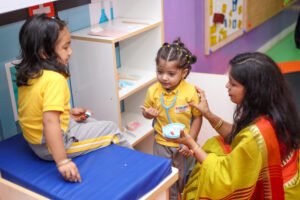In today’s digital age, technology plays an increasingly prevalent role in education, even at the preschool level. We recognise the power of technology to enrich learning experiences at Kidzonia International Preschool. However, we recognise the significance of establishing a balance and being aware of its advantages and disadvantages. In this blog article, we will look at the role of technology in preschool education, emphasising both its advantages and disadvantages within the context of Kidzonia International Preschool.
The Advantages of Technology in Preschool Education:
Increasing Preschoolers’ Engagement and Interaction:
Technology has the potential to capture and engage preschoolers, making learning more pleasurable and participatory. We employ age-appropriate educational applications, interactive whiteboards, and digital learning tools at Kidzonia International Preschool to
Foster active participation and hands-on exploration.
Stimulate curiosity and motivation for learning.
Provide interactive and multisensory experiences.
Personalised Learning: Technology enables personalised learning experiences that are tailored to individual requirements and learning styles. We use adaptive learning tools and educational platforms in our preschool to assess children’s skills and give customised learning routes.
Assess children’s abilities and provide customized learning pathways.
Offer interactive activities that adapt to each child’s progress.
Differentiate instruction to support children at varying skill levels.
Provide participatory activities that are tailored to each child’s developmental stage.
Differentiate teaching to meet the needs of students with varied ability levels.
Access to Extensive Learning Resources: The internet and digital resources provide a plethora of instructional tools that may supplement preschool education. We use technology at Kidzonia International Preschool to:
Access a broad choice of age-appropriate movies, e-books, and educational websites.
Beyond the classroom, investigate virtual field excursions and cultural activities.
Introduce youngsters to many points of view and global learning possibilities.
Developing technical Literacy: Incorporating technology into preschool education assists children in developing technical literacy abilities, preparing them for life in the digital age.
We aim to familiarise youngsters with fundamental digital tools and interfaces at our preschool.
Encourage appropriate digital citizenship, such as internet safety and ethical technology usage.
Through technology-based exercises, develop critical thinking and problem-solving abilities.
Considerations and limitations:
Screen Time and Physical Health: Excessive screen time may be harmful to one’s physical health and well-being. We carefully monitor screen time at Kidzonia International Preschool and prioritise a balanced approach that includes:
Setting age-appropriate technological boundaries.
Physical exercise and outdoor play are encouraged to support healthy growth.
Maintaining ergonomic settings and taking pauses during technology-based tasks.
Social and emotional development: We believe that technology shouldn’t take the place of or hinder face-to-face interactions and social-emotional learning. Hence, we emphasise the following at our preschool:
Balancing technology-based activities with chances for social connection and play.
Cooperative and group activities that promote social skills and empathy.
Promoting emotional intelligence growth via personal relationships and dialogues.
Multisensory learning and authentic experiences: At Kidzonia we ensure that technology supports, not replaces, hands-on and multisensory experiences.
We provide a variety of tactile materials and manipulatives for hands-on discovery in our preschool.
Encourage youngsters to interact with their surroundings, including nature and real-world things.
Combine digital activities with creative, sensory, and outdoor activities.
Educator advice and Monitoring: When utilising technology, preschoolers need advice and supervision.
Educators regularly supervise and scaffold children’s digital usage
Rather than depending primarily on technology, teachers use it as a tool to promote and improve learning.
Regular professional development is required to provide educators with technical and pedagogical understanding.







